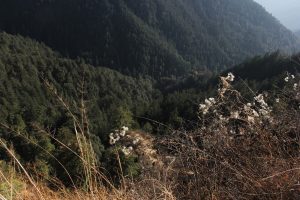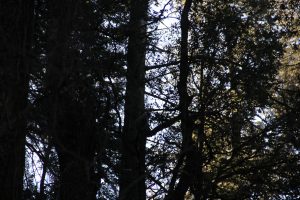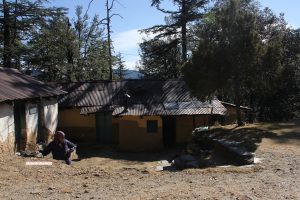They say a jungle teaches you life. There is order in the jungle; there is beauty in the jungle; there is danger in the jungle; there is an originality in the jungle. No animal eats the other without any reason unlike in the human world!


Seog, is a dense forest 30 minutes from Shimla just after Dhalli. A gate beckons you inside. I missed out seeing the statue of the panther and deer on the gate and only saw the birds on the board. There was an option to cycle but the guard coaxed me to trek if I really wanted to enjoy the forests. It was 7.5 km one way, so a 15 km round trek.

Off I went, camera dangling on my chest trying to hear the birds and then strain my eyes to spot them. It was 10 am and already late as the early birds had already caught the worm and went into hiding. Still, I could see a Whistling Thrush and some others.
An insect clinging to a creeper entwining a deodar tree caught my eye as strange but unique!

Two km inside I heard the Barking Deer and looked up the mountain to see a herd passing through the forests during the day’s activity. Just then some one called and insisted I talk. The deer herd had vanished by then. So I put it on silent mode not to miss out on the sheer experience and pin drop silence of the forests, occasionally broken by bird calls. Often I found fresh droppings of the deer, tell-tale signs of it having traversed that way, but no luck anymore. So I enjoyed the overwhelming effect created by the Deodars (Cedrus Deodara) and Moru Oak (Quercus Dilatata) trees. They become home to monkeys, langurs, birds, insects, butterflies and give shade that the sun too cannot pierce. There was not a soul on the trek and I felt like the King of the Jungle.


Once I imagined that our Mogli boy would emerge out of the shadows and show me some of his territory. The boards said that the forests were home to: Black-lored Tit, Rufous Breasted Accentor, Grey Treepie, Rufous Treepie, Jungle Owlet, Red Billed Blue Magpie, Grey Headed Woodpecker, Alexandrine Parakeet, Plumbeous water Redstart, Chestnut tailed Milna, Rufous Sibia, Grey winged Black Bird, Orange flanked Bush Robin, Asian Koel, Black Bulbul, Variegated Laughingthrush, Black Francolin, Blue-capped Redstart, Long Tailed Thrush, Rufous-bellied Niltava, Chestnut Thrush, Yellow Brested Green Finch, Eurasian Treecreeper, Pink browed Rose Finch, Green backed Tit, Slaty headed Parakeet, Green Pigeon, Yellow Bellied Fantail, Common Hoopoe, Black-throated Tit, Great Himalayan Barbet, Whiskered Yuhina, Scaly-breated Munia, Common Tailor Bird, Common Rose Finch, Blue-throated Barbet, Oriental White-eye, Speckled Piculet, Rusty cheeked Scimitar Babbler, Black headed Jay, Plum headed Parakeet and so on. The list is endless.It goes further into the types of Butterflies, Orchids, Shrubs and Flowering Trees.



However, there is a season for everything. So when there are Orchids the trees won’t flower, similarly when the weather is cold the birds and animals prefer to hide and bask in their piece of sunshine.
I walked discovering whatever I could till I came to the end of the trek, where stood a water tank and three huts.

A small temple stood at one side of the huts.

Above this settlement was a Forest Rest House, where no one is allowed during the nights.
Here grew in abundance the yellow Spanish Broom flower (Spartium Junceum). It was a beautiful sight especially when contrasted with the azure blue sky. The best discovery of this trek was this flower called with a Spanish name albeit having the fragrance of a French perfume!

There is a Water Catchment Tank built during the British times at the far end of Seog Trek. It captures mountain spring water and supplies to the city. The pipes are so sturdy that they have not yet been changed!

I saw a village lady whom I wished. She asked me whether I would like to have tea. I said a polite ‘no, thank you’. She again asked me for coffee thinking my taste could be different and supplemented that she makes good coffee. I again said a ‘no thanks’.

Then she offered me Chaaj (Skimmed Milk) to which I said a resounding yes. Neelam, (her name), happily brought fresh Chaaj. I have never had such good chaaj. It was perfect. Then she asked me for lunch. It definitely was lunch time and there was no possibility of finding food in the jungle. I said yes but on a condition that she takes payment for the meal. She hesitated and said that she does not sell food. I did not mean to insult her hospitality but, knew they were very poor folks. She brought me some dal, kadhi and rice, and I must write that it was the best kadhi-chawal I had ever had. Perhaps, the generosity of the poor adds to the taste of food they serve from their kitchen.
In a while her daughter came. I asked her what the daughter was pursuing. Neelam said, that the daughter is a Graduate, and has done some computer courses, takes examinations but doesn’t get placed in a job.
Kalpana, the daughter, and I, spoke. She was full of enthusiasm and was willing to serve anywhere in the country. The girl demonstrated confidence. Of course, having been brought up in a forest where only 4 people (3 of family) lived, she suffered from communication skills in comparison to the city-bred.

I really felt the worthlessness of our University education, which does confer degrees but cannot lead to a job situation. Sloganeering for election purposes is acceptable but, unless education leads to a dignified lifestyle, it is actually not serving its purpose. The issue deserves deep thought at the highest level. What would Kalpana do in a situation she does not get a job. Live off her parents, already old and sick? Live in the jungle grazing cows? Fall into a trap? Go to a city like her brother and engage for a job much below her expectations? Or at best find a job, for which she has no aptitude?
The girl was taking competitive examinations regularly, but what kind of guidance can she get in a situation like this where the forest is the only teacher and master.
There are thousands of such stories abounding in the country. There are many Kalpana’s in remote corners of India, who are fighting out with destiny and struggling to assert their existence.
Unless the country is able to provide, look after and fulfill their aspirations, can we call ourselves free?
Neelam, told me that the forest is peopled by six types of panthers, those she has seen. They once also had a leopard eyeing their cat, who sat for a long time before their hut.
I was only expecting birds and deer at the most. My return thereafter was a very careful walk. Each gust of wind that rustled some dry leaves made me look around for a leaping panther. I saw some bamboo made shelters constructed for sighting birds and deer.


Luckily, I came out unscathed by any animal attack, but scarred by Kalpana’s story!
Please follow and like us:





























































































































